

Benedetto Bonfigli was almost certainly born in Perugia, where he held public office in 1466 and 1471. According to Giorgio Vasari, he was the most highly esteemed painter in the region up to the time of Perugino. His first documented work was a panel (now lost) of the Virgin and two angels that was commissioned in 1445 for a chapel [in/near?] San Pietro. Pope Nicholas V summoned him to Rome in 1446 to decorate various rooms in the Vatican Palace. Payment for this work is documented in 1450, but no trace of it survives.
In 1454, Bonfigli was commissioned to execute the frescoes of the chapel of Palazzo dei Priori (now part of the Galleria Nazionale - see below). The first cycle, which depicts scenes from the life of St Louis of Toulouse was completed in 1461. The second cycle, which depicts scenes from the life of St Herculanus, was unfinished in 1496, the year of Bonfigli's will.
Galleria Nazionale, Perugia
The following works by or attributed to Benedetto Bonfigli are now in the Galleria Nazionale.
Room 14
Madonna and Child with angels (ca. 1450)
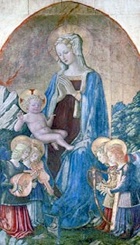
This panel is sometimes associated with payments made to Benedetto Bonfigli and Bartolomeo Caporali in 1467-8 according to the will of a merchant, Francesco di Pietro for an altarpiece for the Cappella di San Vincenzo Ferreri. However, this work would almost certainly have included a figure of St Vincent: that does not rule out a polyptych with the present panel at its centre, although, given its size, the panel was more likely to have been an independent altarpiece.
The panel depicts the praying Madonna against a rocky landscape. Vertical lines to either side of her suggest the back of a throne. The baby Jesus reclines confidently on her lap, holding Himself in place by clutching her gown, while four kneeling angels to the sides play various musical instruments.
Madonna and Child with saints and angels (ca. 1450)
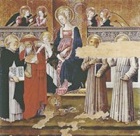
The panel depicts the Madonna and Child enthroned with SS Thomas Aquinas, Jerome (with his lion), Francis and Bernardino in front of a low parapet, behind which stand four praying angels. It is odd that the most prominent of these saints is the Dominican, St Thomas, to whom the baby Jesus passes a bright object that is an allegory of his teaching. Each of the saints holds a book, but that of St Thomas is open, revealing the words that Christ spoke to him as he prayed before a Crucifix: “Bene scriptisi de me Thoma ...” (You have written well of me Thomas ...).
Annunciation with St Luke (ca. 1450)

The co-patrons of the guild were the Virgin Annunciate and St Luke, and this determined the subject of the altarpiece. The Annunciation is set in a Renaissance palace, presumably intended to represent the Virgin’s home. God the Father in a mandorla of seraphim appears against a golden sky above a rocky landscape, surrounded by flying angels, and sends the Holy Spirit towards the Virgin in the form of a dove. St Luke (with the ox that is his usual attribute) squats between the Virgin and the angel Gabriel and records the miracle for his Gospel, as a good notary would. The original predella, which depicted the Pietà with SS Mark and Jerome, still survived in 1822 but was subsequently lost.
Adoration of the Magi (ca. 1466)
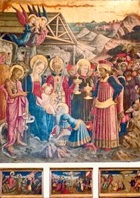
-
✴one of which depicted the Adoration of the Magi; and
-
✴the other of which depicted "many saints".
This altarpiece, which is presumably the first of these, was first recorded in 1548 in the Cappella dei Magi of San Domenico. The merchant, Nicolò di Gasparo di Lello commissioned the chapel in 1464-6, and it seems likely that he also commissioned this altarpiece for its altar.
Like many works in San Domenico, the altarpiece was probably removed from its original location after the collapse of the vaulting of the nave in 1614. It was recorded in the convent in 1683 and in the church in 1712. Although it was listed among the works to be sent to the Musei Capitolini, Rome in 1812, it was subsequently decided that it should remain in the church. It was transferred to the gallery in 1863.
In the main panel, the three kings present their gifts to the baby Jesus, who is on the lap of the Madonna and flanked (as in a conventional sacre conversazione) by SS John the Baptist and Nicholas of Bari (the name saint of the presumed donor). The figures are placed in front of the crumbling stable, which is set in a rocky landscape outside the walled city of Bethlehem.
The predella panels depict:
-
✴the baptism of Christ by St John the Baptist;
-
✴the Crucifixion; and
-
✴a miracle of St Nicholas of Bari.
Gonfalon of San Bernardino (1465)
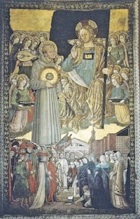
The banner depicts St Bernardino, with his usual attribute of a rayonant disc proclaiming the holy name of Jesus (“IHS”), commending the citizens of Perugia to Christ. He sits in judgement, surrounded by a choir of angels. The citizens are depicted donating candles on the feast of St Bernardino. The bishop blesses the assembly, which includes the leading civic officials and their ladies as well as a number of Franciscan friars and nuns. A small boy is about to steal one of the candles, and the inscription on his sleeve shows a black devil with a warning : “fura che serai apeso” (if you steal, you will hang).
The citizens are assembled in the Piazza di San Francesco, presumably at the end of the annual procession. Behind them is the facade of the Oratorio di San Bernardino, which had been completed only four years earlier. The image of San Francesco al Prato to the right provided important evidence for the original appearance of its facade that facilitated its restoration in 1926.
Angels offering roses (ca. 1464)

-
✴One pair came from the Oratorio dei SS Andrea e Bernardino in 1863.
-
✴The other pair came from the Cappella del Gonfalone, San Francesco al Prato in 1909, the year in which the chapel was closed.
Modern scholarship has determined that the panels were originally arranged in pairs, one above the other, and that they probably decorated two sides of a tabernacle. All of the angels would have looked inwards towards whatever was housed in the tabernacle: the presence of two of the panels in the Cappella del Gonfalone suggests that this was probably the Gonfalon di San Francesco al Prato (above).
Room 21 - Cappella dei Priori
These important the frescoes survive in situ in what is now part of the Galleria Nazionale.
Scenes from the Life of St Louis of Toulouse (1454-61)
In 1454, the chaplain Bartolomeo da Siena commissioned Benedetto Bonfigli to decorate “half of the chapel” with frescoes depicting:
-
✴the Crucifixion with the Virgin and SS John the Evangelist, Laurence and Herculanus on the altar wall; and
-
✴four scenes from the life of St Louis of Toulouse.
One of three named artists - Fra Angelico, Domenico Veneziano or Filippo Lippi - was to evaluate the merits of the completed work and to establish the appropriate price.
The scope of the commission seems to have been changed at a later date, and the fresco of the Crucifixion was never executed. The other four scenes depict (clockwise from the right of the altar wall to the left of the back wall):
-
✴St Louis professing the Franciscan Rule before Pope Boniface VIII;
-
✴St Louis posthumously reuniting a merchant with his purse after a fish had swallowed it (which is set in a cityscape of Perugia is transported to a seaside location, with the Perugian church of San Domenico clearly identifiable above the three arches to the right);
-
✴St Louis performing another miracle (not identifiable because the fresco is badly damaged); and
-
✴St Louis's burial in a church that looks remarkably like the church of San Pietro, Perugia.
Work on these scenes was complete by 1461, when Filippo Lippi ( (the only one of the three named adjudicators who was still alive, who was working in Spoleto) was called to Perugia. He judged that the work was well done and set the price at 400 Florentine florins.
Scenes from the Life of St Herculanus (late 15th century)
Almost immediately, the Priors commissioned Benedetto Bonfigli to decorate the “other half of the chapel” with four frescoes depicting scenes from the life of St Herculanus. Each of these was to be completed in six months so that the work would be completed in two years. Again the commission changed: Bonfigli painted only three scenes, but one of them (see below) occupied the whole of the left wall.
Totila's siege of Perugia

This scene, which is on the right of the back wall, is in two parts:
-
✴On the left, Totila's soldiers are camped in the ruins of the amphitheatre outside Porta Marzia, effecting the siege of Perugia that had begun in 542. It is now 549, and they gather around a fattened ox that St Herculanus has thrown from the walls in order to convince them that the city still has provisions. However, a young cleric testifies on oath before Totila that this is a ruse, and that the city is close to surrender
-
✴On the right, the scene is set after the city has fallen and St Herculanus has been beheaded. A few brave souls recover his body (with the head miraculously in place), together with that of a young boy with whom he had been buried.
This scene is set in a cityscape that gives a valuable picture of Colle Landone before the building of the Rocca Paolina (1540). Thus we see the ruins of the Roman amphitheatre, Porta Marzia before its relocation, the towers of the Baglioni palaces and the church of Sant' Ercolano before the demolition of its upper storey.
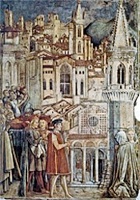
The cityscape shows:
-
✴the portico, campanile and facade of San Pietro before the construction of the outer cloister (on the right in this detail);
-
✴the apse of San Domenico and its campanile, the upper part of which was later demolished (on the left in this detail);
-
✴the campanile of San Domenico Vecchio behind it, which no longer exists; and
-
✴(for a second time) the church of Sant' Ercolano before the demolition of its upper storey.
Translation to the Duomo
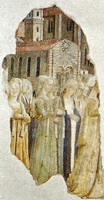
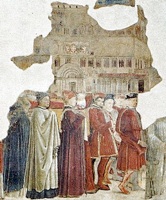
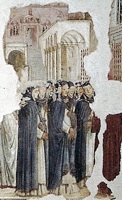
San Domenico Vecchio Palazzo dei Priori Duomo
This scene, which covers the whole of the left wall, depicts the subsequent translation of the relics of St Herculanus from San Pietro to the Duomo in ca. 936. This is logically the last scene in the story, but Bonfigli inserted it between the other two in the clockwise sequence, presumably because the unbroken expanse of the left wall served his compositional needs.
Unfortunately, this fresco is very badly damaged and much of it is completely lost. The surviving fragments of the procession show:
-
✴a group of women passing San Domenico Vecchio (now largely demolished along with its campanile);
-
✴the city magistrates passing along the side of the Palazzo dei Priori; and
-
✴a group of Dominicans about to enter the side door of the Duomo (before its reconstruction in the 15th century), with the Loggia di Braccio extending as far as the (later destroyed) Palazzo del Podestà.
Dating
Although the original contract (1461) stipulated that these frescoes were to be completed in two years, the actual execution took far longer. Bonfigli seems to have downed tools in 1462, probably having completed only the first of the three scenes (the siege of Totila). The main reason seems to have been that the Commune had been slow to pay the 400 Florentine florins that were due in respect of the earlier commission. In 1469, the contract was renegotiated and the Commune assigned to Bonfigli a debt owed by one Bartolomeo di Gregorio.
Some of this money was still outstanding when Bonfigli died in 1496, and he generously stipulated in his will that the balance should be used to complete the decoration of the chapel. This does not necessarily imply that Bonfigli’s frescoes were incomplete at that point: the legacy could have related to the commission of the Decemviri Altarpiece (see below) or to other aspects of the decoration of the chapel.
Two clues can be gleaned from the frescoes themselves:
-
✴the arms of Pope Sixtus IV (1471-84) appear above the entrance to the Palazzo dei Priori on the left wall; and
-
✴the scene of the translation to San Pietro (altar wall) omits two monuments that Bonfigli probably would have included had they been complete:
-
•the octagonal church of the Madonna di Braccio (1478); and
-
•the outer part of Porta San Pietro (completed in 1481).
Another piece of circumstantial evidence is provided by the fact that the Priors commissioned the altarpiece for the chapel in 1479 (see below), suggesting that the frescoes were at least approaching completion. Thus, on balance, it is likely that the last two scenes were largely painted in the 1470s.
Deposit
Pairs of Saints (1467-8)
Giorgio Vasari referred in 1568 to two altarpieces in San Domenico by Benedetto Bonfigli:
-
✴one of which depicted the Adoration of the Magi (see above); and
-
✴the other of which depicted "many saints".
This second altarpiece was probably associated with a payment made to Benedetto Bonfigli and Bartolomeo Caporali in 1467-8 according to the will of a merchant, Francesco di Pietro for an altarpiece for the Cappella di San Vicenzo Ferrer (the 2nd on the left in the nave).
Four panels that probably belonged to this second altarpiece were moved from the sacristy of San Domenico to the Galleria Nazionale in 1863:
-
✴Two panels of the figures of the Annunciation (illustrated above), which are attributed to Bartolomeo Caporali, are exhibited in Room 16. The proposed dating is supported for the first two panels by the fact that some of the details of the Virgin’s study seem to have been inspired by the Gonfalone dell’ Annunziata (1466), which is attributed to Nicolò Liberatore, l’ Alunno and which is now now in Room 12 of the gallery.
-
✴Two panels of pairs of saints, which are attributed to Benedetto Bonfigli, are now in the deposit of the gallery. They might have flanked a central figure of St Vincent Ferrer, thus justifying Vasari's description.
Angels with instruments of the Passion (15th century)
These four panels, have recently been attributed to Benedetto Bonfigli, were moved to the Galleria Nazionale in 1863 as two pairs:
-
✴one pair from the Accademia di Belle Arte; and
-
✴the other from the sacristy of San Francesco al Prato.
Each panel depicts a pair of angels holding instruments of the Passion of Christ. They probably came originally from a niche in San Francesco al Prato that housed a Crucifix or a statue of the Pietà.
Other Works in Perugia
St Bernardino of Siena (ca. 1451)
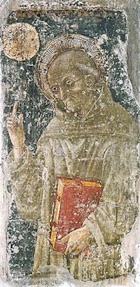
The fresco depicts the saint shortly before his death. He points to a disc in the top lefthand corner that probably originally contained the letters “IHS”, the holy name of Christ.
Gonfalon di San Francesco al Prato (1464)
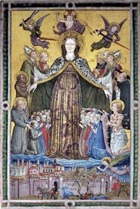
The Franciscans of San Francesco al Prato were closely involved with these moves, following which they instituted a lay confraternity to officiate at the cult. This confraternity built a chapel against the facade of San Francesco al Prato, and the banner was housed in a tabernacle over its altar. In 1923, it was transferred from this chapel (prior to its demolition) to the Cappella degli Oddi, the chapel that abuts the left transept of the church, which offered direct public access. It was moved to its current location in 1996.
The banner shows the Madonna della Misericordia protecting Perugia from angels firing arrows.
-
✴SS Lawrence, Herculanus, Francis, and Bernardino are on the left and
-
✴SS Louis of Toulouse, Constantius, Peter Martyr and Sebastian are on the right.
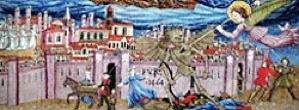
Terrified people are shown fleeing before an interesting cityscape of Perugia. The walls bear an inscription with the date of the outbreak of plague, which is presumably also the date of the commission.
Pietà with saints (1469)
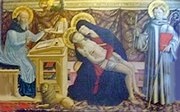
This panel of the Pietà with SS Jerome and Leonard is in San Pietro (at the end of the left aisle). It is undocumented, but used to carry an inscription that identified its date. It used to be attributed to Benedetto Bonfigli, but has been more recently attributed to Fiorenzo di Lorenzo. If the present attribution is correct, it is one of Fiorenzo’s earliest surviving works.
Gonfalone di Santa Maria Nuova (1471)
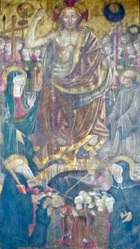
The banner depicts a majestic figure of Christ, who threatens Perugia with arrows. He is surrounded by angels carrying the instruments of the Passion, and flanked by representations of the sun and the moon. The Virgin, SS Benedict and Scholastica and the Blessed Paolino Bigazzini intercede for Perugia. The saints commend the souls of a group of kneeling men and women that includes members of the confraternity, as an angel menaces them with a lance. This scene is set against a cityscape of Porta Sole seen from outside the city wall.
Gonfalone di San Fiorenzo (1476)
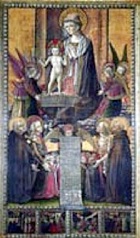
The banner depicts the Madonna with an extraordinary image of the naked baby Jesus standing in a basket of red roses with his arms outstretched, already carrying the marks of the Crucifixion. An angel below carries a scroll with a long poem that exhorts the citizens of Perugia to mend their evil ways. SS Sebastian and Florentius intercede for the city alongside two of the seven founders of the Servite order, both of whom were later canonised:
-
✴St Philip Benizi, who was Prior General of the Servites from 1267 until his death in 1285 and was the first Servite to be canonised (in 1671); and
-
✴St Peregrine Laziosi. As a young man, he slapped Philip Benizi during an affray in ca. 1290, and was converted when his victim turned the other cheek. He became a Servite and later cured himself of cancer of the foot by prayer. He died (from other causes) in 1345 and was canonised in 1726.
The predella shows scenes from the life of St Philip Benizi and and two posthumous miracles performed by St Peregrine Laziosi.
Gonfalon (15th century)
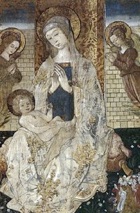
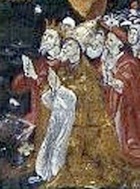
-
✴the Emperor Henry VI;
-
✴Pope Innocent III; and
-
✴St Albert of Jerusalem, the Patriarch of Jerusalem who was claimed to have given the Carmelites their rule shortly before his death in 1214.
This choice of characters was probably motivated by an attempt to prove that the Carmelite Order was the oldest of the mendicant orders.
Madonna della Misericordia (15th century)
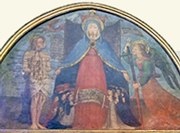
This detached and much repainted fresco from a lunette is now on the left wall of Santa Croce. Some authorities suggest that it was commissioned during the plague of 1429: others attribute it to Mariano d’ Antonio and/or Benedetto Bonfigli, which would suggest a date closer to the 1450s.
The fresco depicts the Virgin shielding the people of Perugia under her cloak, with St Sebastian on the left and an angel holding the sword of faith on the right, [while God the Father fulminates above]. Inscriptions in poetic Italian document an exchange between the Virgin and St Sebastian.
SS Peter Abbot and Benedict (15th century)



St Peter Abbot Displaced Column St Benedict
These frescoes in the nave of San Pietro are attributed to Benedetto Bonfigli, and might have been associated with a payment made to him in 1465. Both frescoes have been heavily repainted.
-
✴The fresco of St Peter Abbot is on the 2nd column of the left, which is known as the column of the miracle. This refers to an accident that happened in ca. 966 during construction, when the column fell and nearly killed a workman. However, St Peter was able to stop it in mid air by making the sign of the Cross. The column remains asymmetrically mounted on its base: the fresco and the cross is carved on the capital above also record the miracle.
-
✴The fresco of St Benedict on the opposite column on the right.
Cartoon (15th century)
The cartoons by Benedetto Bonfigli for the stained glass windows of the Sacristy, San Pietro and the windows themselves no longer survive.
Read more:
F. Mancini, “Benedetto Bonfigli”, (1992) Perugia
V. Garibaldi, “Un Pittore e la sua Città: Benedetto Bonfigli e Perugia”, (1996) Milan
Return to Art in: Perugia.

